Introduction of Concrete Screed
Important Point
A construction element which is available in a range of thickness to bring forth the installation surface of the concrete flooring to a considerable height & to produce a surface suitable for installing the desired flooring is called a concrete screed or what is screed concrete.
Screeds are mortar blended with cementitious or anhydrite binders.
The screed must be sufficiently rigid in nature.
Screeding is the process of setting apart the surplus wet concrete to bring forth the loftiest surface of a slab to the right grade & smoothness.
What Is Concrete Screed?
Screed is a thinner layer of concrete which is typically poured over a base floor to help form a smooth floor coating to provide a strong foundation for the top floor.
Also, Read: Floating Slab Vs Monolithic Slab | What Is Monolithic Slab | What Is Floating Slab
Concrete Screed Specifications
Screed concrete specification: Specifications of a good screed are
- Behave as a substrate that’s necessary for flooring.
- It’ll be generally laid on schedule.
- Its sturdy and durable under various harsh conditions.
- The service conditions specified can be external or internal for either civil, commercial, or industrial flooring purposes, etc.
Useful Article for You
- What Is a Contour Interval
- What Is Tile
- What Is the Difference Between a Shower Pan and a Shower Base?
- What Is Raft
- What Is a Window Panel
- What Is a Frame Structure
- What Is the Measurement for a Queen Size Bed
- What Is Considered Livable Space
- What Is One Way You Can Save Electricity?
- What Is Mdf Mean
- What Is a Bundle of Shingles
- What Is a Gallon of Water Weigh
- What Is Overhang
- Gravity Dam Advantages
- What Is Sand Blasting
- What Is a Span Bridge
- What Is a Mat Slab
- Disadvantages of Low E Glass
- What Is a Highway Flyover
- What Is Transported Soil
- What Is Slab Construction
- What Is Calacatta Quartz
- What Is Hydraulic Cement Used For
- What Is a Tremie
Characteristics of Concrete Screed
The technical & performance properties of screed concrete grade screed are
-
- Sufficient Thickness: Screed thickness is according to the kind of screed planned to put in, the thickness of the floor & its type, and additionally the intensity of estimated traffic.
- Mechanical Resistance: To sustain the ultimate load together with the contribution of the load from the kind of floor, certain mechanical resistance must be gained. It’s recommended to employ the screed for flooring in the domestic purpose & must possess a minimum sturdiness of 20 MPa & in business purpose, the sturdiness is ought to be 30 MPa.
- Compactness: The concrete screed must be compact & homogeneous on the entire surface & throughout the entire thickness. If the screed shows layers or areas that is malleable or possess lower consistency, it’s an indication of poor mechanical characteristics which may result in breakage or the detachment of the flooring.
- Concrete Screed Curing and Dimension: Before the installation of the ground, it’s necessary to check that the screed is correctly placed and cured. This proper curing will let to finish the shrinkages in it if any. During the curing cycles of concrete screed, they’re vulnerable to hygrometric shrinkage. This is due to a part of evaporation of the blending water or the drying process. This shrinkage will lead to curling or cracking of screed& may result in floor detachment.
- Crack Free Screed: The cracks in concrete screed are caused because of hygrometric shrinkage & other reasons. Other reasons are because of the presence of an enormous amount of water within the blend. The utilization of aggregates which are very fine or mix with an excessive amount of cement content also ends up in cracks. The sealing of each crack is finished with high precision by means of epoxy resins. These procedures are followed before the installation of the ground. To resist hairline cracks on screed surfaces, an anti-fracture membrane ought to be utilized.
- Clean: The screed surface must be made tidy. Dust, dirt on the screed surface must be removed before the installation of flooring. Unclean surfaces will end in the prevention of adhesion between the ground & screed.
- Dry: The level of residual humidity must be checked within the screed surface. This value must conform with the most level for that style of covering & must be uniform throughout the entire thickness of the screed. For anhydrite screeds, the amount of residual humidity must be but 0.5%. An electrical or carbide hydrometer is employed for the residual humidity during a screed.
- Flatness: The flatness of the screed is checked by laying a straight edge (2 m long) in each of the directions on the surface of the screed. The utmost acceptable tolerance with this straight edge is specified to be 2 mm. If the flatness isn’t within the tolerance, then the surface must be leveled off employing a suitable product, before polishing off the ground installation
- Smoothness: The suitability of the grade of finish of the surface & also the level of roughness is according to the kind of flooring. For reflective finishing, it’s advised to utilize a skimming product that’s designed specifically for this purpose.
Also, Read: Concrete Mix Ratio | What Is Concrete Mix Ratio | Types of Concrete Mix Ratio
Composition of Concrete Screed
- Admixtures of water & powdered superplasticizers, concrete screeder, cement, & suitable aggregates.
- Special binders ( water & suitable aggregates).
- Blends of aggregates in a granulometric curve to manufacture the screeds.
- Special pre-blended mortars to blend with water.
- Most manufacturers bestow a 1:3 to 1:4.5 ratio of cement to sand in the screed.
- Amplified screeds embrace supplements to bump up the quality of screed.
- This yields quicker drying spans & surplus sturdiness.
- Manufacturers additionally contribute a lot of self-compacting screeds which are anhydrite compounds supported on a CaSO4 binder.
- CaSO4 screeds can’t be ignored but aren’t ideal for soggy areas like wet rooms, steam rooms & pool fringes.
Also, Read: Cinder Block Vs Concrete Block | What Is Cinder Blocks | What Is Concrete Blocks
Defects in Concrete Screed
Defects of concrete screed are
- Cracks
- Surface dust or bleeding
- Crumbly surface
- Fractures around the pipe work
- Localized crumbly surface
- Rising damp
- Insufficient flatness
Useful Article for You
- Moment Frame
- Monolithic Slab
- Zero Force Members
- How Much Does a Yard of Concrete Weigh
- Cmu Wall Meaning
- Gradient Road
- Pile-Cap
- Budget Sunroom Ideas
- What Is Gypsum Board
- Types of Vaulted Ceilings
- How Does Baking Soda Remove Blood from Carpet
- What Are Forms in Construction
- How Heavy Is Dirt
- Tender Meaning in Architecture
- Dark Olive Green House
- Cast in Place Concrete
- Lean to Roof
- What Is a Pitched Roof
- How Tall Is an Average Door
- Grade Beam Foundation
- Sheeps Foot Compactor
- Lvl Beam Size Calculator
Advantages of Concrete Screed
- Durability: A befittingly developed floor screed will outlast the else modules of the building.
- Stiffness: Concrete floors generally possesses adequate prudery & does not parry under the applied load which result in generating problems in non-structural elements, e.g. doors.
- Energy Efficiency: Concrete floors generally possesses lofty thermal mass & this may be utilized to ameliorate the inner environment within the dwelling & diminish the energy demand for thermal solace.
- Speed of Construction: Concrete floors will be developed rapidly. The embrace of concrete floor boosts up the completion of the bottom floor. Precast flooring systems have the surplus superiority of diminishing the bulk of drudgery required.
- Damp Resistance: Concrete floor is non-absorbent. This is often utilized for water retaining floors identically as stores.
- Cost of Maintenance: Concrete floor is effortless to wash & also the perpetuation expense of concrete floor is affordable.
- Fire Resistance: Concrete is non-flammable & is fire-resistant.
Disadvantages of Concrete Screed
- Defects on concrete floors don’t seem to be effortless to amend.
- The concrete flooring can’t be adequately renovated by patch job.
- It doesn’t possess satisfying insulation features against sound & heat.
Application of Concrete Screed
- The screed for concrete can be bonded to the bottom or laid unbonded onto an acceptable moist resistant veil which is required to be placed up & above the wodge.
- Moreover, It can be applied as a floating finish over a film of taut insulation substance.
- This is additionally suitable to be utilized with cast-in water pipes to generate underfloor heating.
- In case of reinforcement, this will be within a metal mesh, fibres which are conventionally polypropylene, or a fine glass network.
- Few manufacturers provide flowing screeds which can be sprayed to achieve level finishes.
- Most of those screeds are anhydrite compounds & supported on a CaSO4 binder.
- They’re brisk to utilize than a conventional sand & cement screed & will be applied to a minimal murkiness of 25 mm if bonded, 30 mm if unbonded, or 35 mm if a floating finish is required.
Concrete Screed
In the United States, screeding is the process a person called a concrete finisher performs by cutting off excess wet concrete to bring the top surface of a slab to the proper grade and smoothness. A power concrete screed has a gasoline motor attached, which helps smooth and vibrate concrete as it is flattened.
Screed Floors
Screed is a thinner layer of concrete which s typically poured over a base floor to help form a smooth floor coating to provide a strong foundation for the top floor.
Why Do You Screed a Floor?
The screeds primary purpose, using one part cement to three to five parts sharp sand, is to give a smooth and level floor on which to lay your chosen floor finish. The thickness of the screed allows it to take up normal variations in flatness and levelness of the base on which it is laid.
Can Screed Be Used as a Floor Finish?
Screed is usually applied on top of the concrete slab and is most commonly used as a finishing layer on internal floors or to level the floor prior to final floor coverings carpet, tiles, natural stone, linoleum, wood flooring, resin coatings etc.
Concrete Screed Specifications
A minimum thickness of 25 mm is required for a fully bonded screed, 50 mm for an unbonded screed and 65 mm for a floating screed (i.e. on top of insulation). 75 mm is the minimum in a commercial environment for a floating screed.
Characteristics of Concrete Screed
- Sufficient Thickness.
- Mechanical Resistance.
- Compactness.
- Concrete Screed Curing and Dimension.
- Crack Free Screed.
- Clean.
- Dry.
- Flatness.
Composition of Concrete Screed
A floor screed is usually a cementitious material made from a 1:3 or 1:4.5 ratio of cement to sharp sand. It may be applied onto either a solid in-situ concrete ground floor slab or onto a precast concrete floor unit.
Defects in Concrete Screed
- Cracks.
- Fractures around pipework.
- Bleeding or surface dust.
- Crumbly surface.
- Crumbly throughout entire thickness.
- Rising damp.
- Insufficient flatness.
Advantages of Concrete Screed
Liquid cement screed creates a smooth and even surface that could easily accommodate different floor coverings such as carpet or tiles. Because it is self-levelling, it does not require the use of men on their hands and knees using leveling boards, unlike the traditional screed installation.
Disadvantages of Concrete Screed
- Defects on concrete floors are not easy to rectify.
- The concrete flooring cannot be satisfactorily repaired by patch work.
- It does not possess very satisfying insulation properties against sound & heat.
Application of Concrete Screed
Screed is usually applied on top of the concrete slab and is most commonly used as a finishing layer on internal floors or to level the floor prior to final floor coverings carpet, tiles, natural stone, linoleum, wood flooring, resin coatings, etc.
What Is the Purpose of Screed Concrete?
The screeds primary purpose, using one part cement to three to five parts sharp sand, is to give a smooth and level floor on which to lay your chosen floor finish. The thickness of the screed allows it to take up normal variations in flatness and levelness of the base on which it is laid.
When Should You Screed Concrete?
Screeds are required when a colourful or functional floor is needed rather than a bare concrete surface. For industrial purposes, or commercial locations, which will undergo frequent traffic, a more robust screed is required than is used in DIY or residential projects.
What Is the Ratio for Concrete Screed?
Screed is usually a cementitious material made from a 1:3 to 1:4.5 ratio of cement to sand. A simple cement and sand mix will be fine for a simple application but more sophisticated mixes are suitable for a wider range of applications. Some of these new compounds can be laid on substrates other than concrete.
Can I screed over concrete?
Generally concrete requires coarse and tough aggregates. For example screed might use fine sand whereas concrete will need gravel and sharp sand to give it a tougher, stronger and more robust quality. Screed should be applied in a thin layer over the concrete base as a final coating.
Like this post? Share it with your friends!
Suggested Read –
- Top 10 Best Cement Companies In India 2021
- What Are the Disadvantages of Epoxy Flooring?
- What Is Stone Masonry | Types of Stone Masonry
- Tension Vs Compression | What Is Tension & Compression
- What is BoQ | BoQ Meaning | Advantages of BoQ | What is BoM
- Soak Pit Design | Health Aspects | Operation and Maintenance of Soak Pit | Applicability of Soak Pit Design
- What Is Superelevation | Superelevation Definition | Superelevation Formula | Calculation of Superelevation in Roads
- Brick Masonry | 6 Types of Bricks | Types of Brick Masonry Work | 4 Types of Brick Bond | 5 Classification of Bricks Based on Size Modification
Originally posted 2023-09-23 14:35:28.
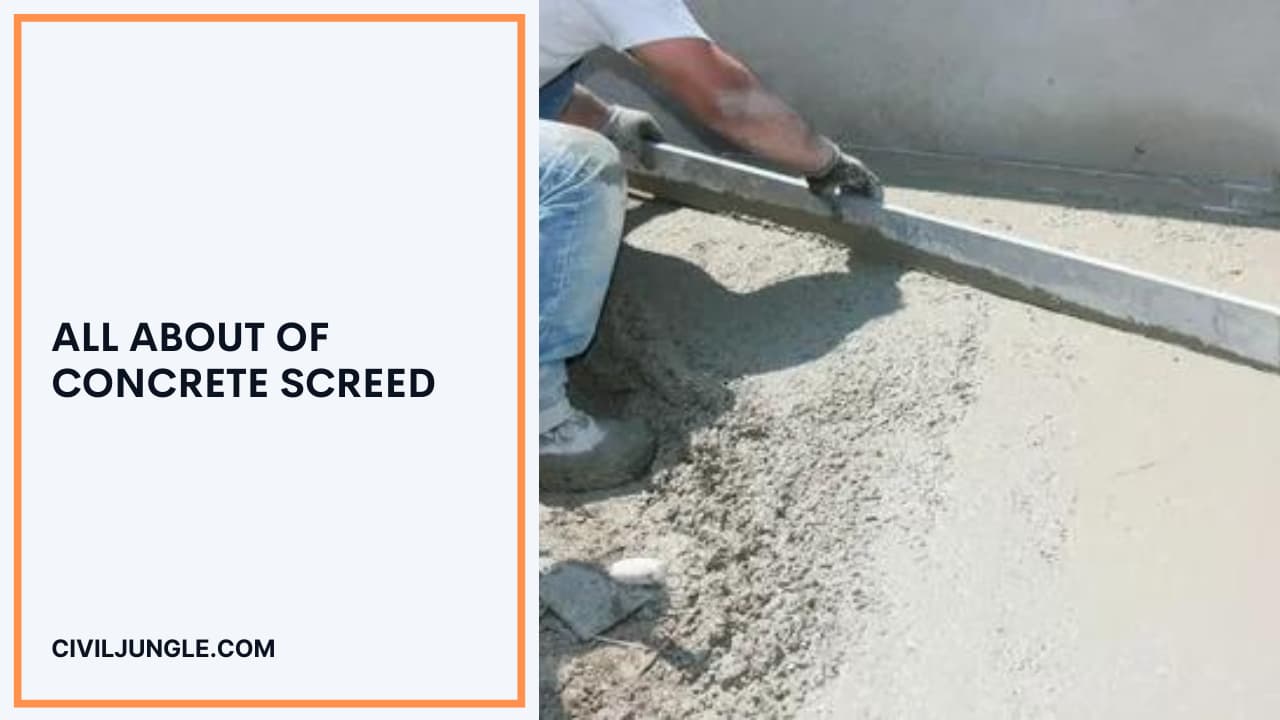
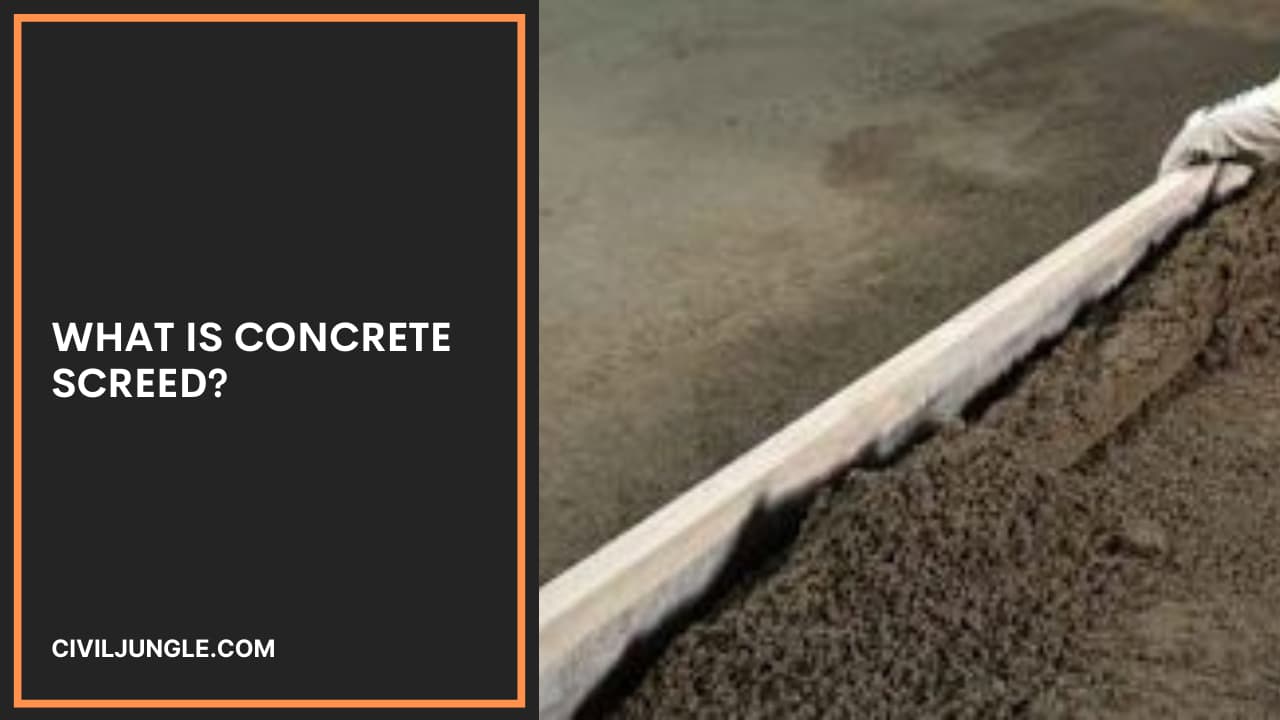

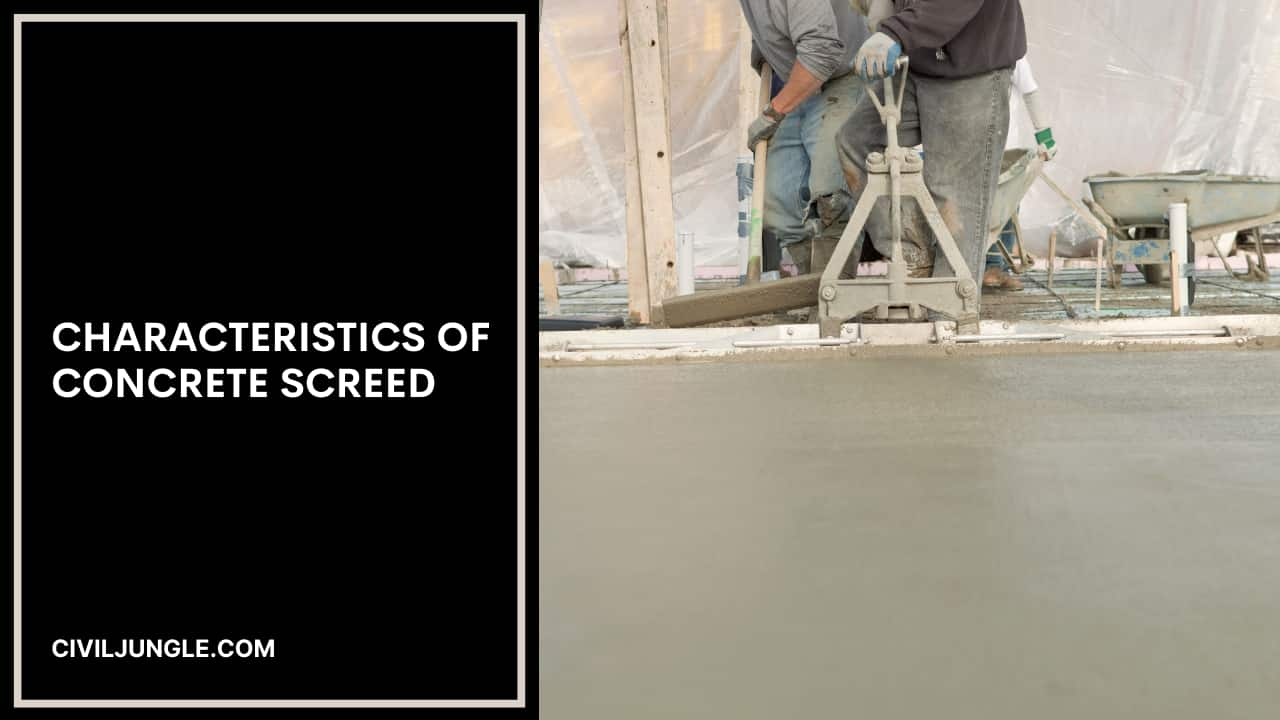
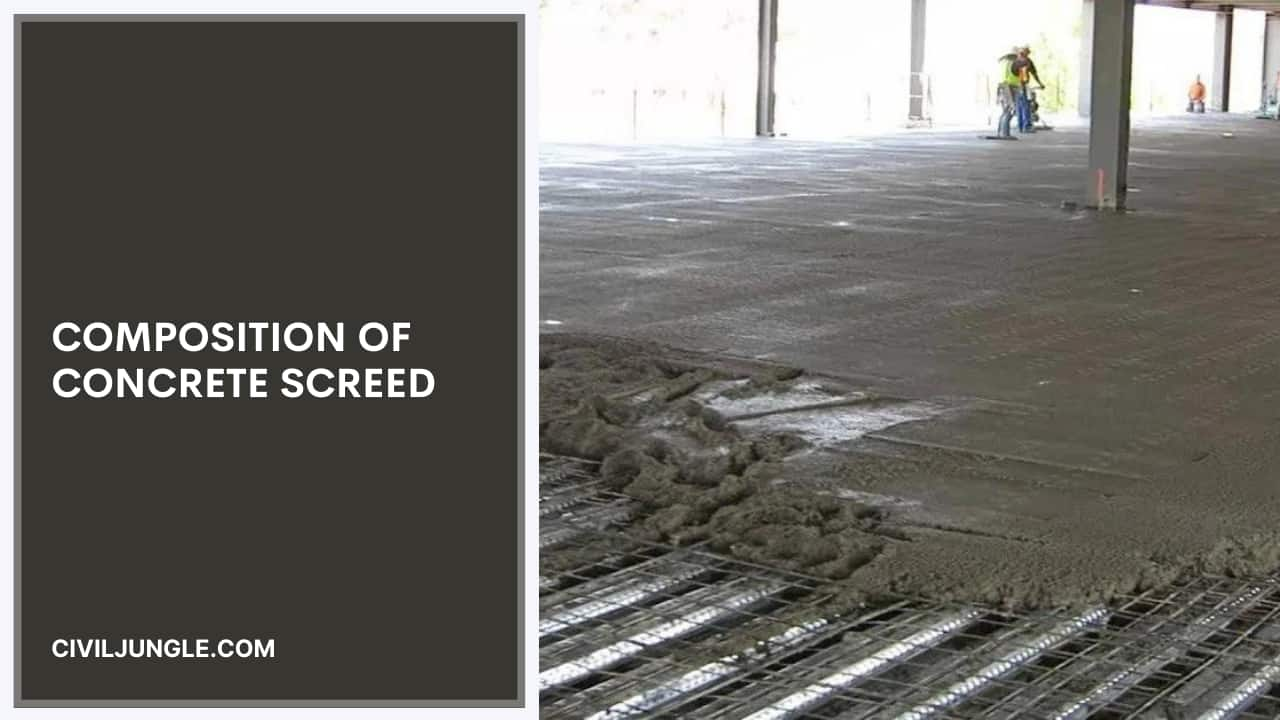
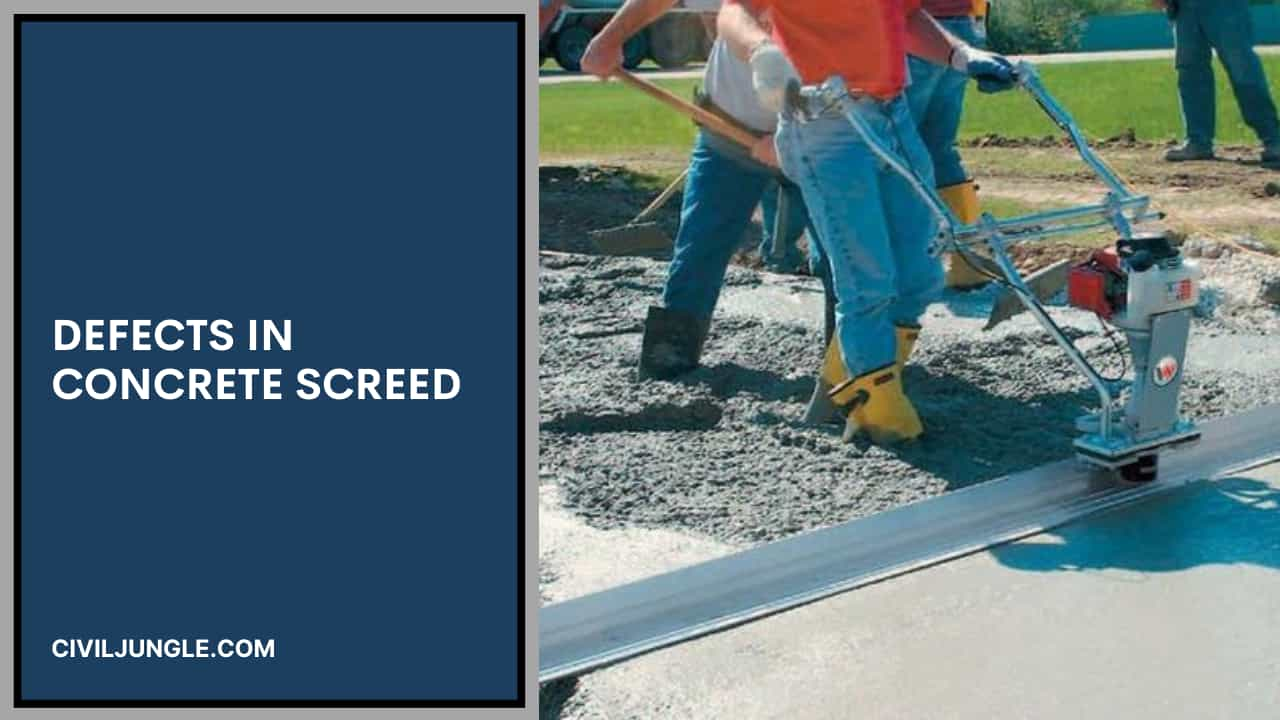
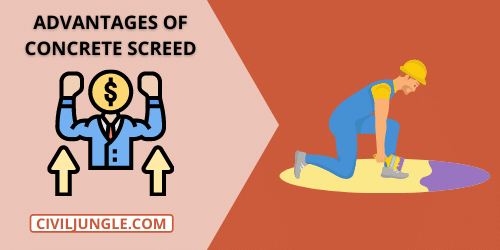
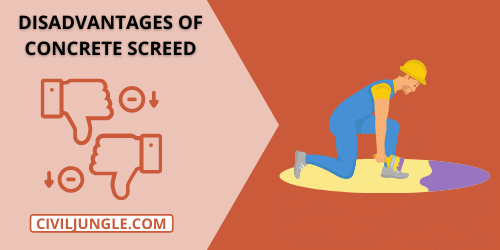

Leave a Reply